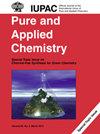A critical review of the quantification, analysis and detection of radionuclides in the environment using diffusive gradients in thin films (DGT): advances and perspectives
IF 2
4区 化学
Q3 CHEMISTRY, MULTIDISCIPLINARY
引用次数: 0
Abstract
This critical review explores the quantification, analysis, and detection of radionuclides in the environment using the diffusive gradients in thin films (DGT) technique. Radionuclides, unstable isotopes emitting ionising radiation, are present in the environment due to natural and anthropogenic sources for which concerns are raised about their impact on human health and ecosystems. DGT offers a unique passive sampling approach for understanding the behaviour of radionuclides and other trace elements. This review provides insights into method development, real case scenarios, advantages, limitations, and future perspectives of DGT in radionuclide analysis. In terms of method development, various isotopes have been analysed with varying significance based on origin, concentration, risks, and persistence. Notably, U, Th, Pu, Am, Cm, 99Tc, 226Ra, 137Cs, 134Cs, 232U, 237Np, and 152Eu have been measured, revealing their diverse roles in environmental radioactivity. Real case scenarios illustrate applications in uranium mining, water quality monitoring, and metal speciation studies, shedding light on mobility, bioavailability, and ecological impacts. DGT’s advantages include利用薄膜中的扩散梯度(DGT)对环境中的放射性核素进行量化、分析和检测的重要综述:进展与展望
这篇评论探讨了如何利用薄膜扩散梯度(DGT)技术对环境中的放射性核素进行量化、分析和检测。放射性核素是释放电离辐射的不稳定同位素,存在于自然和人为来源的环境中,其对人类健康和生态系统的影响令人担忧。DGT 为了解放射性核素和其他痕量元素的行为提供了一种独特的被动采样方法。本综述深入探讨了 DGT 在放射性核素分析中的方法开发、实际应用场景、优势、局限性和未来展望。在方法开发方面,根据来源、浓度、风险和持久性,对各种同位素进行了意义不同的分析。值得注意的是,U、Th、Pu、Am、Cm、99Tc、226Ra、137Cs、134Cs、232U、237Np 和 152Eu 均已测量,揭示了它们在环境放射性中的不同作用。实际案例说明了在铀矿开采、水质监测和金属标样研究中的应用,揭示了迁移性、生物利用率和生态影响。DGT 的优势包括原位监测、时间平均浓度和全面的标本分析。面临的挑战包括生物污损、温度变化的潜在影响,特别是长期接触电离辐射可能导致的结合层和扩散层退化。此外,完全易变的游离金属离子和部分易变的金属配体复合物之间的区别给 DGT 技术带来了潜在的限制,因此也是未来研究的一个机遇。展望未来,DGT 预计将为辐射剂量建模、环境风险评估和水质监测做出贡献,其持续发展将提高其实用性和准确性。
本文章由计算机程序翻译,如有差异,请以英文原文为准。
求助全文
约1分钟内获得全文
求助全文
来源期刊

Pure and Applied Chemistry
化学-化学综合
CiteScore
4.00
自引率
0.00%
发文量
60
审稿时长
3-8 weeks
期刊介绍:
Pure and Applied Chemistry is the official monthly Journal of IUPAC, with responsibility for publishing works arising from those international scientific events and projects that are sponsored and undertaken by the Union. The policy is to publish highly topical and credible works at the forefront of all aspects of pure and applied chemistry, and the attendant goal is to promote widespread acceptance of the Journal as an authoritative and indispensable holding in academic and institutional libraries.
 求助内容:
求助内容: 应助结果提醒方式:
应助结果提醒方式:


